|
Notes: Spellow station was situated on the London & North Western Railway’s (LNWR) Bootle Branch which ran from Edge Hill via the northern suburbs of Liverpool to the Docks. The line was primarily opened to cater for goods traffic and it opened from Edge Hill to Stanley on 1 June 1866 and through to Canada Dock on 15 October 1866. Initially passenger services only ran as far as Tue Brook which was to the south of Spellow. In 1870 the LNWR extended the passenger service through to Canada Dock. On 5 September 1881 a branch was opened from the Bootle Branch just to the east of Canada Dock station to Alexandra Dock and passenger services were operated on it.
At Walton, which lay to the north of Liverpool, the Bootle branch passed under the main Liverpool and Preston Road (County Road) in a deep cutting. By the 1880s Walton had developed from a small village into a residential suburb of Liverpool. To serve the rapidly expanding area the LNWR opened Spellow station in September 1882.
The station possessed a street level over-track building on the east side of County Road. The building was a single-storey brick structure with segmental-arched openings under a half-hipped roof. The main entrance at street level gave access to the booking hall and a door at the rear of the building connected to a staircase down to the footbridge; from here further staircases led down to the two facing platforms (the line being a double-track railway). All three staircases and the footbridge were roofed. On reaching the platforms passengers were sheltered by hipped, glazed awnings supported by the sheer sandstone walls of the cutting through which the railway passed, and by a series of metal pillars.
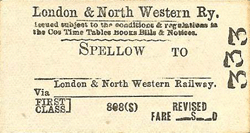 By 1890 a signal box had opened at Spellow a short distance east of the down platform. The box was an LNWR type with a 14-lever frame. By 1890 a signal box had opened at Spellow a short distance east of the down platform. The box was an LNWR type with a 14-lever frame.
At the time of opening up trains (Edge Hill direction) ran to Liverpool Lime Street and down trains ran to either Canada Dock or to Alexandra Dock.
The December 1895 timetable showed an intensive train service of 30 up and 31 down services on Monday-to-Saturday. Twenty of the down trains went to Alexandra Dock with 11 going to Canada Dock. No trains ran on Sunday.
The down services were well used by dock workers but the up direction trains suffered from competition. This was because the route to Liverpool Lime Street from Spellow was anything but direct. Trains travelled towards the east, then turned south before finally heading west into the centre of Liverpool. In all they travelled nearly six miles from Spellow to Liverpool Lime Street; the route into Liverpool by road was only two miles. Horse-drawn trams were introduced to Walton in the late 1860s but in 1902 the tramway was electrified providing a much better service to Liverpool than the LNWR could offer.
Tramway competition did lead to a reduction in the passenger services from Spellow and the July 1922 timetable showed 18 up and 19 down trains on Monday-to-Friday. Five of the down services ran to Canada Dock and 14 to Alexandra Dock. On Saturday there were five fewer services in each direction; this still represented a good level of service for those wishing to travel to the outer suburbs and to the docks.
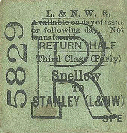 On 1 January 1923 Spellow Station became part of the London Midland & Scottish Railway (LMS). In summer 1932 there were five trains from Spellow to Canada Dock, 12 to Alexandra Dock and 17 to Liverpool Lime Street on weekdays. The first departure from Spellow was for Alexandra Dock and it left at 6.49am. The last departure, at 10.39pm, was for Alexandra Dock. On 1 January 1923 Spellow Station became part of the London Midland & Scottish Railway (LMS). In summer 1932 there were five trains from Spellow to Canada Dock, 12 to Alexandra Dock and 17 to Liverpool Lime Street on weekdays. The first departure from Spellow was for Alexandra Dock and it left at 6.49am. The last departure, at 10.39pm, was for Alexandra Dock.
On 28 August 1940 Liverpool suffered its first bombing raid of the Second World War and in the following months the city suffered greatly. The Canada Dock branch was of national strategic importance and so was targeted by the Luftwaffe. Many of the bombs that were aimed at the line fell on the residential area around Spellow station. In very heavy raids on 4 May 1941 the Leeds & Liverpool Canal was hit at Canada Dock station and the ensuing flood brought about the withdrawal of passenger services. Although the station was brought back into use for goods it did not reopen to passengers; this left Spellow with only the Alexandra Dock and Liverpool Lime Street service.
The summer 1947 timetable showed a much reduced service of only five trains to Alexandra Dock and six to Liverpool Lime Street on Monday-to-Friday only. There was also a train from Liverpool Lime Street that terminated at Spellow.
On 1 January 1948 Spellow Station became part of the nationalised British Railways’ London Midland Region (BR[LMR]). BR[LMR] withdrew the passenger service between Alexandra Dock and Liverpool Lime Street on 31 May 1948. In the 1949 summer timetable Spellow was shown to be served by one up and one down service. These trains ran only between Spellow and Liverpool Lime Street and called at no other station. It is not known if these services actually ran. Spellow had no goods facilities so it closed completely after the passenger services were withdrawn.
Spellow signal box was closed on Sunday 19 November 1950.
 After closure the street level station building was used by a series of retail outlets including a furniture store and, in more recent years, a betting office. The station infrastructure at track level fell into a state of disrepair and the footbridge and awnings had been removed by the early 1960s. After closure the street level station building was used by a series of retail outlets including a furniture store and, in more recent years, a betting office. The station infrastructure at track level fell into a state of disrepair and the footbridge and awnings had been removed by the early 1960s.
Through passenger coaches between Southport Chapel Street and London Euston had run through Spellow since the LNWR days. They continued to operate after 1949. The line had always been a busy freight artery and it remained so until the late 1960s after which the number of trains reduced dramatically. In the mid 1960s the Southport-London through coaches were replaced by DMUs which continued to operate until 9 October 1977. In 1982 Canada Dock closed to goods services but, in compensation, from 1980 container services had begun to operate to the north docks. In the latter half of the 1980s trainloads of imported coal started to use the line and this was followed in the 1990s by scrap metal trains. Coal traffic had ceased by 2016 but it was replaced by consignments of biomass.
Tickets from Michael Stewart, timetable from Paul Wright and route map by Alan Young
Sources:
To see the other stations on the Canada Dock branch click on the station name: Canada Dock, Walton & Anfield, Breck Road, Tue Brook,
Stanley & Edge Lane
See also Alexandra Dock branch stations:
Bootle Balliol Road and Alexandra Dock (LNWR)
See also:
Canada Dock Goods and Atlantic Dock Junction |

old3.jpg)

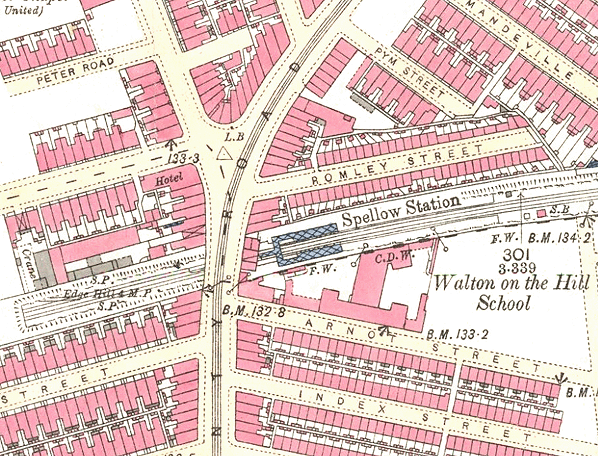
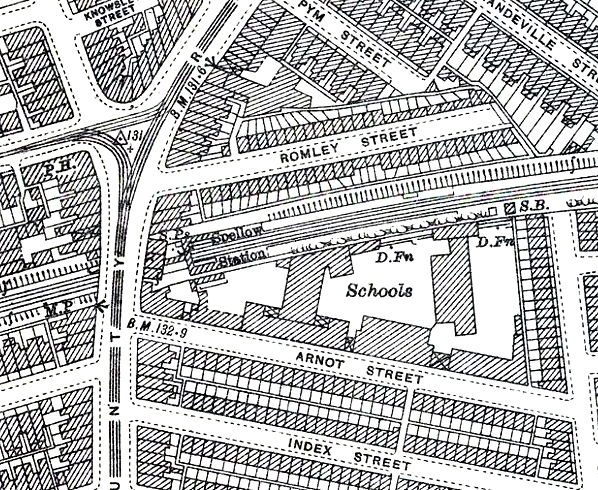

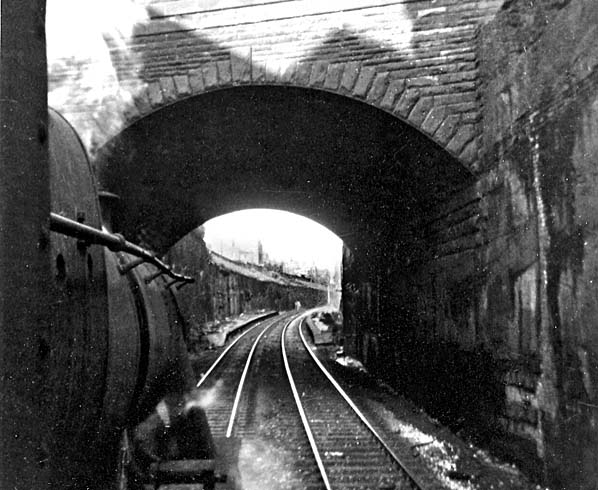
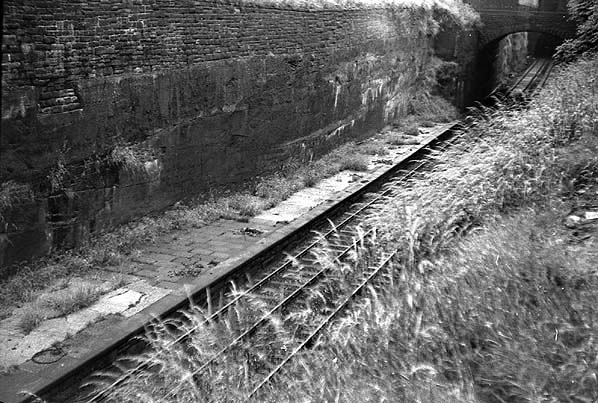

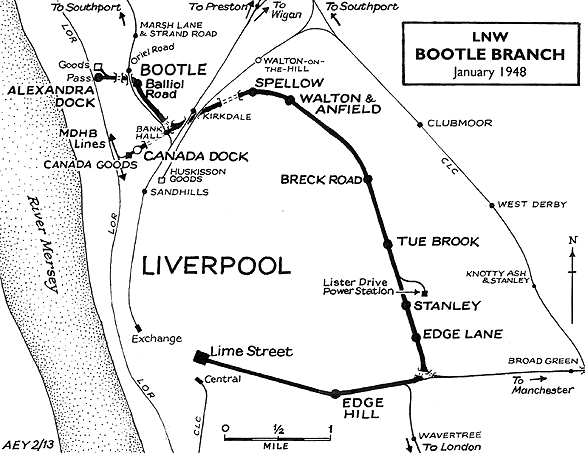
 By 1890 a signal box had opened at Spellow a short distance east of the down platform. The box was an LNWR type with a 14-lever frame.
By 1890 a signal box had opened at Spellow a short distance east of the down platform. The box was an LNWR type with a 14-lever frame.  On 1 January 1923 Spellow Station became part of the London Midland & Scottish Railway (LMS). In summer 1932 there were five trains from Spellow to Canada Dock, 12 to Alexandra Dock and 17 to Liverpool Lime Street on weekdays. The first departure from Spellow was for Alexandra Dock and it left at 6.49am. The last departure, at 10.39pm, was for Alexandra Dock.
On 1 January 1923 Spellow Station became part of the London Midland & Scottish Railway (LMS). In summer 1932 there were five trains from Spellow to Canada Dock, 12 to Alexandra Dock and 17 to Liverpool Lime Street on weekdays. The first departure from Spellow was for Alexandra Dock and it left at 6.49am. The last departure, at 10.39pm, was for Alexandra Dock. 
 After closure the street level station building was used by a series of retail outlets including a furniture store and, in more recent years, a betting office. The station infrastructure at track level fell into a state of disrepair and the footbridge and awnings had been removed by the early 1960s.
After closure the street level station building was used by a series of retail outlets including a furniture store and, in more recent years, a betting office. The station infrastructure at track level fell into a state of disrepair and the footbridge and awnings had been removed by the early 1960s. 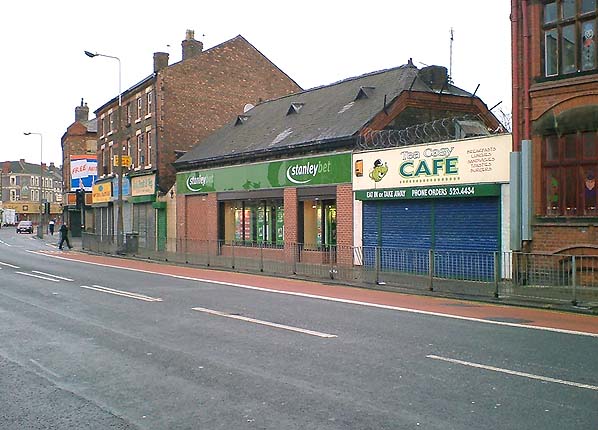
 Home Page
Home Page